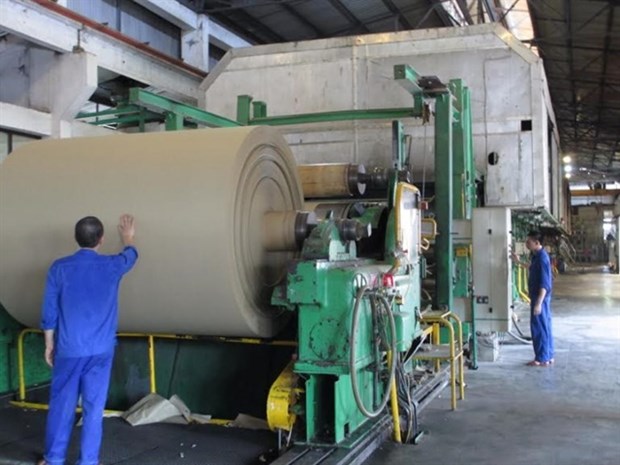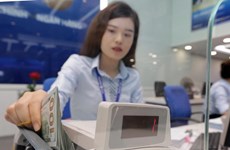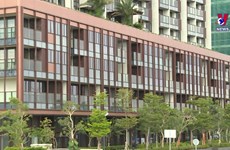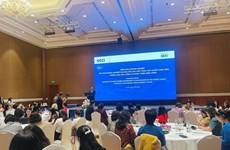Vietnam paper industry needs to diversify product portfolio
The paper industry has potential for growth, but businesses need to avoid investment in products that have excess supply, according to the Vietnam Paper and Pulp Association (VPPA).
 A paper mill (Photo: vppa.vn)
A paper mill (Photo: vppa.vn)HCM
City (VNA/VNS) - The paper industry has potential for growth, but
businesses need to avoid investment in products that have excess supply,
according to the Vietnam Paper and Pulp Association (VPPA).
It said free trade agreements such as the Comprehensive and Progressive Agreement for Trans-Pacific Partnership (CPTPP) and the Vietnam-EU FTA would open up opportunities for industries that use a lot of paper products, like garment and textile, and footwear, as well as export opportunities for the paper industry itself.
Speaking to Viet Nam News, Hoang Trung Son, the association’s vice chairman, said the industry has achieved average annual growth of 10-12 percent, with packaging paper sales growing at 15-17 percent.
Exports of paper materials and finished paper products last year were worth nearly 1.1 billion USD, an increase of 50 percent from 2017.
In the domestic market, demand for packaging, tissue, writing and printing papers could increase by 10-20 percent this year, he said.
But paper firms face fierce competition both at home and abroad, he said.
Printing and writing paper production in China has gone up sharply this year, but it faces difficulties in exporting due to the US-China trade war, and so would increase exports to other countries, including Vietnam, according to VPPA.
Other countries such as Indonesia, Thailand and Japan are also eyeing the Vietnamese market, it said.
Son said demand for packaging paper in the domestic market is high, but supply has increased faster than demand, leading to oversupply.
“There is an imbalance in investment in the paper industry, with most new projects in the last three years focusing on normal packaging paper.
“Vietnam still has to import high-quality packaging paper, coated paper and even photocopy paper.
“We export normal packaging paper, and then import high-quality paper such as duplex and paper for making paper glasses.
“Vietnamese firms need to adjust their product structure, stop investing in normal packaging paper because supply exceeds demand and invest in other types ... such as shoe lining paper, paper for wrapping clothes, high-quality packaging paper, and coated, duplex, couche and bristol paper.”
According to the association, per capita paper consumption in Vietnam is around 51kg per year compared to the world average of 58kg. So demand would continue to increase by 8-10 percent annually, it said.
Son said with the current movement to reduce plastic waste, demand for paper bags and wrapping paper would increase.
Material shortage
Investment in the pulp sector in Vietnam remains modest, making the industry reliant on imported raw materials.
“Import demand will surely increase rapidly,” Son said.
Addressing the lack of raw materials is among the keys to sustain the industry’s development, he said.
There are around 500 enterprises in the industry, mostly small- or medium-sized or household businesses.-VNA/VNS
It said free trade agreements such as the Comprehensive and Progressive Agreement for Trans-Pacific Partnership (CPTPP) and the Vietnam-EU FTA would open up opportunities for industries that use a lot of paper products, like garment and textile, and footwear, as well as export opportunities for the paper industry itself.
Speaking to Viet Nam News, Hoang Trung Son, the association’s vice chairman, said the industry has achieved average annual growth of 10-12 percent, with packaging paper sales growing at 15-17 percent.
Exports of paper materials and finished paper products last year were worth nearly 1.1 billion USD, an increase of 50 percent from 2017.
In the domestic market, demand for packaging, tissue, writing and printing papers could increase by 10-20 percent this year, he said.
But paper firms face fierce competition both at home and abroad, he said.
Printing and writing paper production in China has gone up sharply this year, but it faces difficulties in exporting due to the US-China trade war, and so would increase exports to other countries, including Vietnam, according to VPPA.
Other countries such as Indonesia, Thailand and Japan are also eyeing the Vietnamese market, it said.
Son said demand for packaging paper in the domestic market is high, but supply has increased faster than demand, leading to oversupply.
“There is an imbalance in investment in the paper industry, with most new projects in the last three years focusing on normal packaging paper.
“Vietnam still has to import high-quality packaging paper, coated paper and even photocopy paper.
“We export normal packaging paper, and then import high-quality paper such as duplex and paper for making paper glasses.
“Vietnamese firms need to adjust their product structure, stop investing in normal packaging paper because supply exceeds demand and invest in other types ... such as shoe lining paper, paper for wrapping clothes, high-quality packaging paper, and coated, duplex, couche and bristol paper.”
According to the association, per capita paper consumption in Vietnam is around 51kg per year compared to the world average of 58kg. So demand would continue to increase by 8-10 percent annually, it said.
Son said with the current movement to reduce plastic waste, demand for paper bags and wrapping paper would increase.
Material shortage
Investment in the pulp sector in Vietnam remains modest, making the industry reliant on imported raw materials.
“Import demand will surely increase rapidly,” Son said.
Addressing the lack of raw materials is among the keys to sustain the industry’s development, he said.
There are around 500 enterprises in the industry, mostly small- or medium-sized or household businesses.-VNA/VNS













